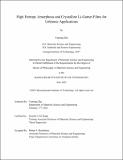| dc.description.abstract | Safe, reliable, and Li+-conductive solid-state electrolytes are considered the key to unlocking the potential of solid-state and hybrid batteries, as well as lithionic devices beyond batteries, such as memristors and environmental gas sensors. The materials class of Li-garnet-type Li7La3Zr2O12-d (LLZO) has garnered attention because of its high Li+ conductivities, wide electrochemical stability windows, and non-flammability. However, high-temperature sintering (>1050 °C) is generally required to achieve its highly conductive cubic phase (cLLZO), which raises concerns over processing cost, sustainability, and interface stability with adjacent layers, such as cathodes. Alternative, amorphous LLZO (aLLZO) phases require lower temperatures for synthesis as compared to their crystalline counterparts, making this material an attractive option for use in solid-state batteries and beyond. However, to date, their amorphous local structure and structure-transport relationships have not been properly explored. In addition, the low-temperature synthesis routes to stabilize various aLLZO to cLLZO phases have rarely been discussed.
This thesis investigates the structure nature of a new class of high-entropy aLLZO phases and defines their low-temperature synthesis conditions towards lithionic applications. First, we explore the synthesis conditions and local structure of aLLZO and contextualize them with existing Li+-conductive oxides. These high-entropy glass-ceramic phases consist of the highest number of local building units (LBUs) ≥ 4 being identified so far with edge- and face-shared LBUs, not conforming to the traditional Zachariasen glass formation rules. Within the aLLZO structure, we identify Zr and Li as network formers, facilitating the formation of LBU connections via bridging oxygen. A model study is next designed to confirm the role of La as a network modifier. Increasing the La concentration in aLLZO promotes local disordering. Moreover, low-temperature synthesis options for aLLZO and cLLZO are explored through crystalization enthalpy analysis and the development of the 1st Time-Temperature-Transformation (TTT) diagram for LLZO. We confirm the successful synthesis of cLLZO at a record-low temperature of 500 °C, about half of the temperature used for classic sintering. Finally, recent advancements and challenges towards the device integration of Li+-conductive films are analyzed. This thesis sets the cornerstone for future structure optimization of high-entropy aLLZO glass-ceramics and provides low-temperature synthesis guidelines to assist the integration of aLLZO and cLLZO into lithionic devices. | |
